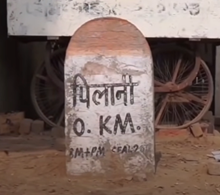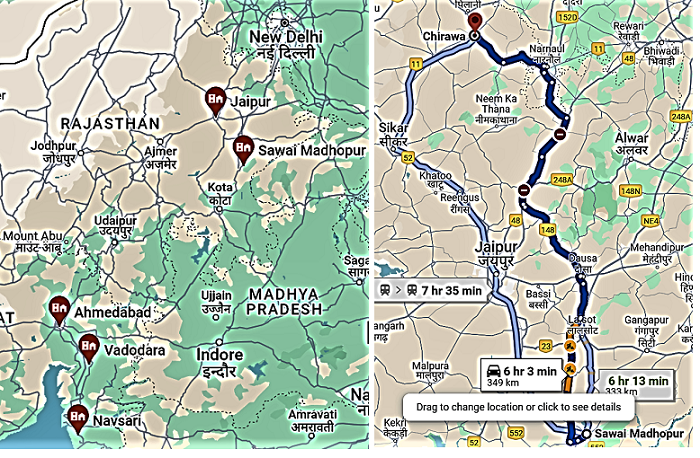Once off-loaded at the bus adda at the Bazar of the Pilani city, before I could locate the gate to the campus, I was surrounded by a few pedal-rickshaws. With my looks and the luggage that I was carrying, that was certainly not surprising. Each one announced, synchronously as if pre-programmed – ten rupees. As I was to find out during my subsequent visit, the default transport charge was Rs.5 and that such call nor invitations were not required for the regular students. The regular students would just settle into any rickshaw and curtly announce the name of hostel block. Once reaching the destination, he would hand over a 5-rupee note and walk on the hostel. However, since such auto-invite, with seemingly pre-orchestrated price-tag was tell-tale indication that they, and perhaps who would have cared to throw a glance at me there, would have identified me as a fresher.
I declared my destination and settled into one rickshaw. Then, it seemed to me that I reached the designated hostel block, Budh Bhavan, in almost the fast-forward motion. Hardly had I settled on the slightly sloping seat of the rickshaw, we were at the hostel gate. Rickshawwallah even indicated where I should go, which incidentally, was the office where the candidates were required to register. As he drove off, I thought I saw a fleeting smile on his face. It was fleeting that neither then, nor even now, I am able to comprehend whether it was look of pity, a smirk, or a mocking gesture or a good wish!
At the hostel office, I was duly registered, allotted a room on the first-floor right wing facing the main road. I was also informed of the location of the mess and timings of the meals. I was required to deposit the room and meal charges for five days. I was also informed of the location of Admissions Office area and was informed that further details relating to admission test will be made available when I report there. I was advised to report at least an hour before the appointed time.
I located the allotted room and unpacked my luggage. The fact that I had finally reached the hostel room seemed to engulf me with the boredom and fatigue of the travel. Therefore, without wasting any more time, I readied myself for the bath. To wash off all the dust and grime as well as the fatigue and boredom off the body, I had had a good half-an-hour refreshing bath, the first task I took up was to write a postcard, which I was to post next day after the test, briefly informing my parents that I had reached BITS Pilani quite comfortably.
Then, I took a quick reconnaissance tour of the entire block of Budh Bhawan. I do not remember now whether I did come across any other candidate at that time.
My travel fatigue – and tension – now gone, I was feeling hungry. So, just as my watch declared the time for dinner, I walked over to the mess and had my first meal at the hostel. Except that it was quite a satisfying meal, I do not remember much about it. What I ever do, is in fact because of meals consumed later during the say there, hence, as such I will take up when I reach that part of the narrative.
Here, too, neither I made any conscious effort to make new acquaintances, nor perhaps any else too tried to be acquainted with me.
Once my the then primary need of hunger was well-satisfied, my next need in the priority of hierarchy was sleep. Once back at the room, I kept flipping of the pages of the magazine. The letters were passing across my eyes, but mind seemed to be in some trance, so not a word did get registered. In fact, that seeming-to-read activity had worked like a sleeping pill. Soon, I was sound asleep, to wake up around 5.30 or so in the next morning.
I was now fully fresh and rearing to go, with not a thought of what the result for the test would be. I finished off my morning routine very leisurely, again to be ready for the breakfast, probably in the very first batch. Here, too, finished off my breakfast alone. In fact, I still wonder, how it should have so happened that I had not opened the account of my acquaintances all this while. I am basically a hermit, but not much to say even a hello to anyone. And, I do not think I was after all that much of an alien for someone to wave a hand or just make an eye-contact!
However, I will not deny that my eyes were not registering anything except that test. Whether it was a subconscious undercurrent of fear of the test or it was tension of lack of knowledge of what was lying the store of the future, I am not able to decode it even now.
Be that as it may, I was now off the Admissions Office ………
We will visit The Campus in next two episodes.




 In my view the one glaring factor responsible for this disconnect was the misfitting uniform. We did learn about fit and tolerance, as applicable to the engineering, later in the course, but if there could be only one classic example of a ‘misfit’, it was our uniform. Perhaps since the uniform had to be reused next year for some other student, we were not allowed to carry out any major alteration to enable the uniform to fit our bodies. As a result, perhaps everyone thought that he, definitely, looked like a caricature in that uniform. Moreover, the misfit also did not make it any easier to perform the physical activities on the ground. As a result, the uniform also used to get the same treatment that our boiler suit used to get, except that it used to washed and ironed a little more frequently because of the sheer force of disciplinary actions on the ground. Interestingly, Vasant Pujara candidly admits that he
In my view the one glaring factor responsible for this disconnect was the misfitting uniform. We did learn about fit and tolerance, as applicable to the engineering, later in the course, but if there could be only one classic example of a ‘misfit’, it was our uniform. Perhaps since the uniform had to be reused next year for some other student, we were not allowed to carry out any major alteration to enable the uniform to fit our bodies. As a result, perhaps everyone thought that he, definitely, looked like a caricature in that uniform. Moreover, the misfit also did not make it any easier to perform the physical activities on the ground. As a result, the uniform also used to get the same treatment that our boiler suit used to get, except that it used to washed and ironed a little more frequently because of the sheer force of disciplinary actions on the ground. Interestingly, Vasant Pujara candidly admits that he